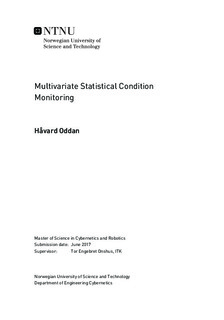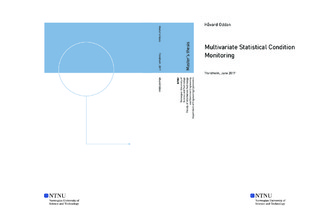| dc.description.abstract | Multivariate analysis methods have been studied for the purpose of improving condition monitoring of equipment in industry. This concerns fault detection, isolation and diagnosis for machinery in order to improve decision support capabilities for condition based maintenance, improved safety and reliability. Multivariate analysis techniques such as Principle Component Analysis and Partial Least Squares Regression have been investigated for this purpose, and applied to four different case studies.
Two case studies was based on data collected at Statoil's industrial processing facilities at Tjeldbergodden. One of these cases regarded a steam turbine compressor, where multivariate statistical methods where tested in order to evaluate their performance for fault detection and fault isolation. PCA and PLSR analysis was used and demonstrated a good performance for fault detection and fault isolation when data from a known fault condition was tested. The machine experience a non-stationary behaviour in the period of the analysis, which reduced the made use the multivariate methods more difficult and caused some false alarms.
The second case study regarded a steam turbine generator also from Tjeldbergodden. The performance of this machine was analyzed over a period of approximately two years. The results from the analysis was that a clear trend was detected from PCA analysis, which corresponded with a gradual loss of performance of the machine experienced in the same period. This case study demonstrated the use of multivariate analysis methods for discovering hidden information in relatively large data sets.
The third case regarded vibration analysis of a ball bearing. Vibration data from different working conditions of the bearing was used, including both healthy and faulty conditions. After signal conditioning, features from the vibration signal was extracted both from wavelet packet decomposition and time domain. The extracted features was then subject to the dimension reduction technique of PCA which was further used for fault detection and fault classification. The PCA analysis proved that faulty condition could be detected. SIMCA analysis was also used for classification. The classifier had good performance in classifying new samples of healthy condition and two distinct fault conditions.
The last analysis regarded acoustic signal monitoring of an air compressor, where wavelet packet decomposition was utilized for features extraction. PCA was further used in fault detection together with T^2 and SPE, based on training data and testing data for several fault conditions. SIMCA classification was used to train 8 different classes corresponding to the fault conditions and the healthy condition. Testing the classifier on new data samples revealed that the PCA based classification was not optimal, as nonlinear relations in the data could not be captured. | |

